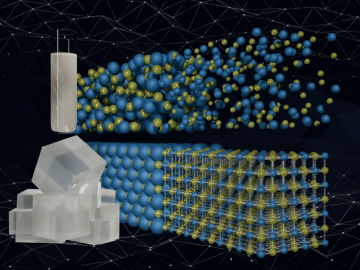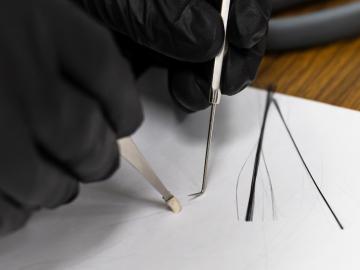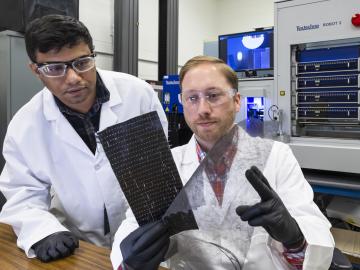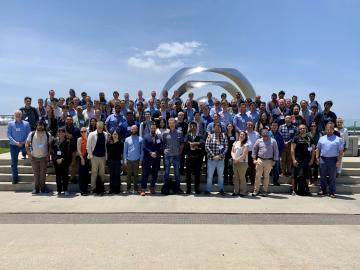
Filter News
Area of Research
- Advanced Manufacturing (2)
- Biology and Environment (113)
- Biology and Soft Matter (1)
- Computational Biology (1)
- Computational Engineering (2)
- Computer Science (11)
- Electricity and Smart Grid (3)
- Energy Frontier Research Centers (1)
- Energy Science (112)
- Functional Materials for Energy (1)
- Fusion and Fission (26)
- Fusion Energy (15)
- Isotopes (1)
- Materials (72)
- Materials for Computing (12)
- Mathematics (1)
- National Security (28)
- Neutron Science (35)
- Nuclear Science and Technology (13)
- Quantum information Science (9)
- Sensors and Controls (1)
- Supercomputing (98)
News Topics
- (-) Coronavirus (48)
- (-) Environment (218)
- (-) Exascale Computing (67)
- (-) Fusion (66)
- (-) Grid (74)
- (-) Machine Learning (68)
- (-) Nanotechnology (64)
- (-) Quantum Science (92)
- 3-D Printing/Advanced Manufacturing (146)
- Advanced Reactors (40)
- Artificial Intelligence (131)
- Big Data (79)
- Bioenergy (112)
- Biology (128)
- Biomedical (73)
- Biotechnology (39)
- Buildings (74)
- Chemical Sciences (86)
- Clean Water (33)
- Composites (35)
- Computer Science (226)
- Critical Materials (29)
- Cybersecurity (35)
- Education (5)
- Element Discovery (1)
- Emergency (4)
- Energy Storage (114)
- Fossil Energy (8)
- Frontier (64)
- High-Performance Computing (130)
- Hydropower (12)
- Irradiation (3)
- Isotopes (62)
- ITER (9)
- Materials (157)
- Materials Science (158)
- Mathematics (12)
- Mercury (12)
- Microelectronics (4)
- Microscopy (56)
- Molten Salt (10)
- National Security (86)
- Neutron Science (171)
- Nuclear Energy (122)
- Partnerships (68)
- Physics (69)
- Polymers (35)
- Quantum Computing (53)
- Security (31)
- Simulation (65)
- Software (1)
- Space Exploration (26)
- Statistics (4)
- Summit (71)
- Transportation (103)
Media Contacts

Scientists have developed a new machine learning approach that accurately predicted critical and difficult-to-compute properties of molten salts, materials with diverse nuclear energy applications.

Stronger than steel and lighter than aluminum, carbon fiber is a staple in aerospace and high-performance vehicles — and now, scientists at ORNL have found a way to make it even stronger.

Researchers at ORNL have developed an innovative new technique using carbon nanofibers to enhance binding in carbon fiber and other fiber-reinforced polymer composites – an advance likely to improve structural materials for automobiles, airplanes and other applications that require lightweight and strong materials.

Members of the Quantum Science Center, or QSC, gathered at an all-hands meeting in Baton Rouge, Louisiana, in mid-May to reflect on the remarkable accomplishments from the past five years and to prepare for what members hope to be the next five years of the center.

ORNL’s Biological Monitoring and Abatement Program, or BMAP, is marking 40 years of helping steward the DOE’s 33,476 acres of land on which some of the nation’s most powerful science and technology missions are carried out.

As the focus on energy resiliency and competitiveness increases, the development of advanced materials for next-generation, commercial fusion reactors is gaining attention. A recent paper examines a promising candidate for these reactors: ultra-high-temperature ceramics, or UHTCs.

Paul is exploring the next frontier: bridging quantum computing with neutron science. His research aims to integrate quantum algorithms with neutron scattering experiments, opening new possibilities for understanding materials at an atomic level.

The fifth annual Quantum Science Center, or QSC, Summer School at Purdue University, held Apr. 21 through Apr. 25, 2025, welcomed its largest group of students to date. Experts from industry, academia and national laboratories gathered at the Purdue Quantum Science and Engineering Institute to share their research in multiple areas of quantum science.

A research team from the Department of Energy’s Oak Ridge National Laboratory, in collaboration with North Carolina State University, has developed a simulation capable of predicting how tens of thousands of electrons move in materials in real time, or natural time rather than compute time.

Analyzing massive datasets from nuclear physics experiments can take hours or days to process, but researchers are working to radically reduce that time to mere seconds using special software being developed at the Department of Energy’s Lawrence Berkeley and Oak Ridge national laboratories.


